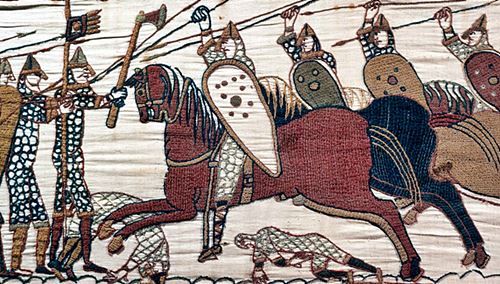
Battle of Montemaggiore |
year: 10414 May 1041 |
| A defeat of the Byzantines by the Normans | ★ ★ ★ ★ ★ |
|
enemy: Normans, Lombards
|
location: South of Monte Maggiore, on the Ofanto river, south of Foggia in Italy
|
accuracy:
●●●●●
|
|
battle type: Pitched Battle |
war: Norman Conquest of Southern Italy |
modern country:
Italy |
| ▼ The Byzantines(emperor: Michael IV the Paphlagonian) | ▼ The Enemies | |
| Commander: | Catepan Michael Dokeianos | Atenolfo, Guillaume d’Hauteville |
| Forces: | <18,000 | 700 knights, 1300 infantry |
| Losses: |
| Background story: |
| General dissatisfaction (mainly due to taxes) in Southern Italy against Byzantium had begun at least since 1039. In 1040 it took the form of a violent rebellion. After the first successes, it spread, especially when Maniakes was recalled back to Constantinople. We are talking about a “rebellion” here, because the Lombards and the Normans who participated were subjects or vassals or allies of the Byzantines until then. In fact, some of the protagonists of the uprising, like Lombard Arduino and Norman William d’ Hautville had served and had distinguished themselves in Maniakes’ Byzantine army during the Sicilian campaign. After the battle of Olivento the rebels gained new support while some of the nobles and local lords of South Italy came out as opponents of the Byzantines. Head of the rebellion was elected now the brother of the Lombard prince of Benevento, Atenolfo. The Catepan of Italy Michael Doceianos, after his defeat at Olivento in March 1041, tried to organize a better army by taking units from the Sicilian army, including the Varangian detachment, led by Harald Hardrada (who later became king and national hero of Norway). Doceianos moved against the rebels to get revenge for his previous defeat. He was accompanied by two Greek Rite bishops from Troia and Ofanto. |
The Battle: |
 Norman knights The rebel army is estimated to have numbered about 2,000, of which 700 were Norman knights. Their leader were William d’ Hauteville (for the Normans) and Atenolfo (for the Lombards). The Byzantine army was much larger, but rather less that 18,000, which is the figure given in Annales barenses – The Chronicles of Bari. The Byzantine army formed two lines. The Normans attacked in a spearhead formation, which led the first line to be driven into the second, and in turn causing confusion among the Byzantines. William suffered from fever that day and initially watched the fight from a hill, but eventually joined the battle as he was overcome with excitement. A great number of Byzantine soldiers, including the two bishops, drowned in the Ofanto attempting to flee. A particularly great number of Varangians also fell in battle,and the Byzantines were eventually defeated. The Norman victory has been attributed in particular to the addition of the Norman heavy cavalry. The Norman knights were becoming the new formidable force of the battlefields of that era. The victory at Montemaggiore provided the Normans with their first significant acquisition of war booty, including military equipment, horses, tents, precious fabrics, as well as gold and silver vessels. The enrichment of the soldiers in turn attracted more knights to join the rebellion. |
Aftermath: |
| With the Byzantine army crushed, Michael Dokeianos fell back to the port of Bari, requesting new reinforcements from Sicily. Soon however Dokeianos was replaced by Exaugustus Boioannes. The Lombard-Norman revolt was followed by a third and final battle, the Battle of Montepeloso in September 1041. Gradually the Normans were taking command of the situation and soon would prevail in south Italy. |
|
|
